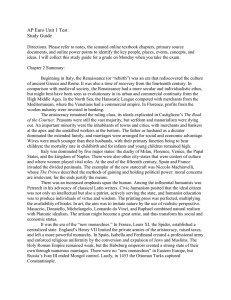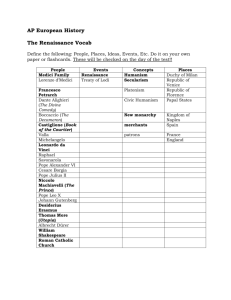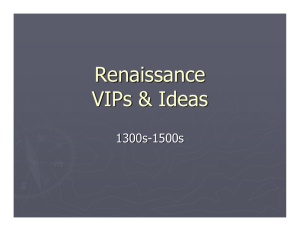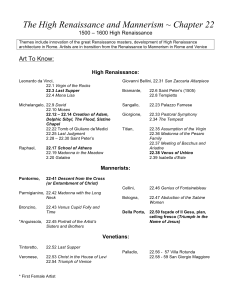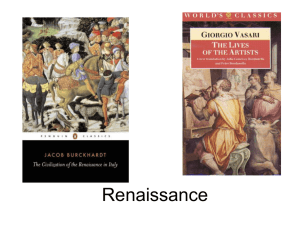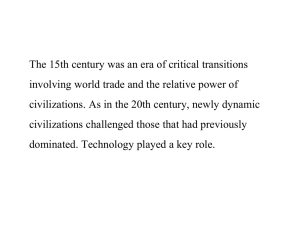Chapter Ten Review: The Renaissance in Italy: Renaissance: rebirth
advertisement
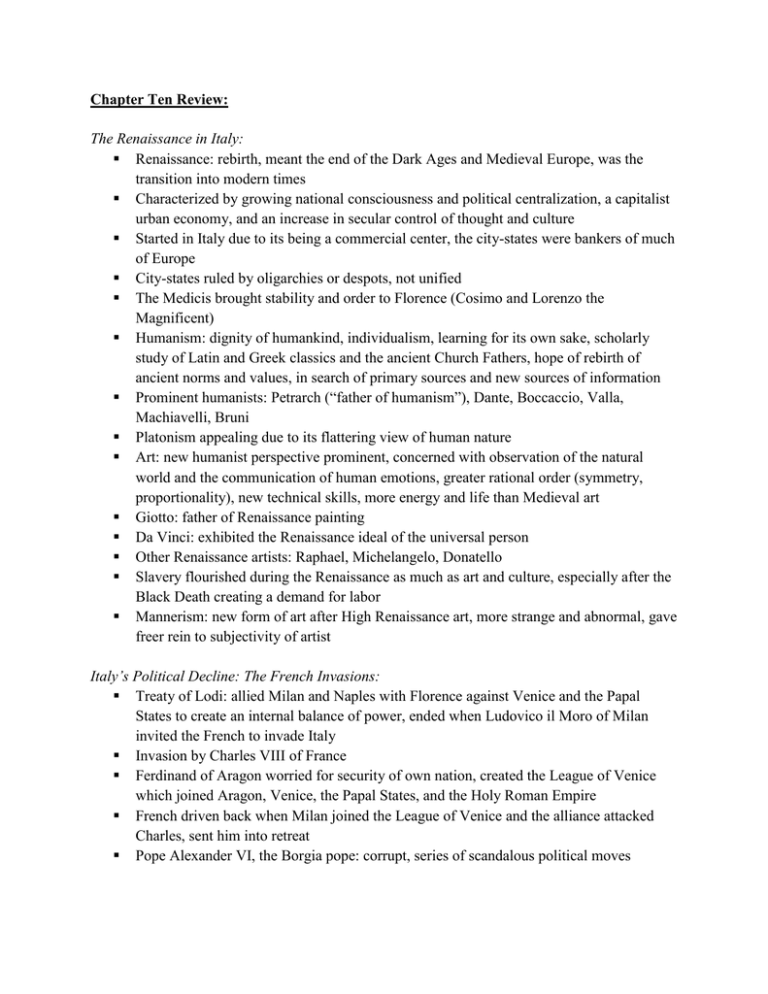
Chapter Ten Review: The Renaissance in Italy: Renaissance: rebirth, meant the end of the Dark Ages and Medieval Europe, was the transition into modern times Characterized by growing national consciousness and political centralization, a capitalist urban economy, and an increase in secular control of thought and culture Started in Italy due to its being a commercial center, the city-states were bankers of much of Europe City-states ruled by oligarchies or despots, not unified The Medicis brought stability and order to Florence (Cosimo and Lorenzo the Magnificent) Humanism: dignity of humankind, individualism, learning for its own sake, scholarly study of Latin and Greek classics and the ancient Church Fathers, hope of rebirth of ancient norms and values, in search of primary sources and new sources of information Prominent humanists: Petrarch (“father of humanism”), Dante, Boccaccio, Valla, Machiavelli, Bruni Platonism appealing due to its flattering view of human nature Art: new humanist perspective prominent, concerned with observation of the natural world and the communication of human emotions, greater rational order (symmetry, proportionality), new technical skills, more energy and life than Medieval art Giotto: father of Renaissance painting Da Vinci: exhibited the Renaissance ideal of the universal person Other Renaissance artists: Raphael, Michelangelo, Donatello Slavery flourished during the Renaissance as much as art and culture, especially after the Black Death creating a demand for labor Mannerism: new form of art after High Renaissance art, more strange and abnormal, gave freer rein to subjectivity of artist Italy’s Political Decline: The French Invasions: Treaty of Lodi: allied Milan and Naples with Florence against Venice and the Papal States to create an internal balance of power, ended when Ludovico il Moro of Milan invited the French to invade Italy Invasion by Charles VIII of France Ferdinand of Aragon worried for security of own nation, created the League of Venice which joined Aragon, Venice, the Papal States, and the Holy Roman Empire French driven back when Milan joined the League of Venice and the alliance attacked Charles, sent him into retreat Pope Alexander VI, the Borgia pope: corrupt, series of scandalous political moves Pope Julius II: the “warrior pope,” brought the Renaissance papacy to a peak of military prowess and diplomatic intrigue, secular papacy commented on by Erasmus in Julius Excluded from Heaven France invaded Italy multiple times, wearing them down more each time, led to the Habsburg-Valois wars between France and Spain, France lost all of them Cultural peak of Italy was also its political tragedy, convinced Machiavelli that a unified Italy must occur, wrote The Prince on that and other subjects Revival of Monarchy in Northern Europe: Shift from divided feudal to unified national monarchies as sovereign rulers emerged, triumph of “one” over “many” France: o King Louis XI created a secure and efficient government, led to a debilitating foreign policy under later monarchs o Cornerstones of French nation building: Collapse of English Empire in France after the Hundred Years’ War, defeat of Charles the Bold of Burgundy Spain: o Union of Isabella of Castile and Ferdinand of Aragon brought two kingdoms together, strengthened Spain o Subdued their realms, secured their borders, ventured abroad militarily, and Christianized the whole of Spain, overseas exploration and the establishment of the Spanish Empire in Mexico and Peru England: o Internal warfare between the House of York and the House of Lancaster o War of the Roses o Henry Tudor became Henry VII, subdued the nobility using the Court of Star Chamber o Began to shape a monarchy that would develop into one of Europe’s most exemplary governments under Elizabeth I Holy Roman Empire: o Exception to steady development of centralized lands o Territorial rulers and cities dominated, 300 autonomous political entities o Golden Bull unified them in the machinery of law and order, however, and later the Reichstag did the same thing The Northern Renaissance: More diverse social backgrounds, more devoted to religious reforms More willing to write for lay audiences Helped by the invention of the printing press, spread humanist ideas Erasmus: most famous northern humanist, educational and religious reformer, aspired to unite the classical ideals of humanity and civic virtue with the Christian ideals of love and piety, believed in the power of primary sources above all others Humanism influenced reform of Germany, England, France, and Spain Voyages of Discovery and the New Empire in the West: Beginning of western Europe’s global expansion and the transference of commercial supremacy from the Mediterranean and the Baltic to the Atlantic coast of Europe Henry the Navigator: Portuguese prince who sponsored the exploration of the African coast, main motivation was the gold trade Rush for spice markets of India Spanish Empire in the New World: conquest, exploitation, and administration of vast American empire Influx of precious metals led to inflation in Europe Spanish conquered the Aztecs and the Incas, caused the end of their civilizations/empires Created an “economy of exploitation,” wholly extractive economy exemplified by silver mining and forced labor Peninsulares vs. Creoles New wealth in Europe enabled governments and private entrepreneurs to sponsor basic research and expansion in the printing, shipping, mining, textile, and weapons industries New wealth and industrial expansion led to aggravated social divisions, indirectly prepared the way for the Reformation
